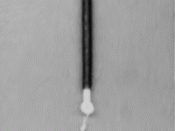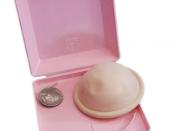Whatever an individual's beliefs, it can be said that birth control issues have helped shape our society and other societies around the world. It is important for humanity to examine the history behind various birth control methods to truly appreciate our modernization today. From ancient Egypt to modern America, people have attempted to control the human reproductive process. With all the trials and tribulations conducted on birth control methods, the invention of the birth control pill still surfaced. Studying the history and uses of potions, barrier methods and withdrawal methods that were traced back from thousands of years ago allow us to learn and understand the past so that we, as a society, can value and appreciate our future.
Ancient Egyptian and Romans had a difficult time revealing the truths about the human reproductive system. Without the education needed for human anatomy, their methods for preventing births were mainly trial and error.
Egyptian papyruses dated from around 1850 B.C. show recipes for vaginal suppositories thought to be effective in preventing a woman from conceiving while ancient Romans sought birth control because they did not feel that hoards of children fit with their highly civilized urban lifestyles (Clemitt). Like us today, the ancient Greek and Romans wanted a better understanding and more control over their lives. Later in 200 A.D., a Greek gynecologist named Seranus coined the much needed discovery of the term ovulation as the period of time when women were fertile, occurring during a menstruation cycle (Oyler). With these new findings and many questions on prevention, Seranus suggested that women smear olive oil, pomegranate pulp, ginger or tobacco juice around the vagina in order to kill sperm. He also suggested simpler methods such as drinking the water that blacksmiths used to cool metals in and jumping backwards seven times immediately after intercourse to dislodge sperm. Even with the new discoveries in menstruation, professionals in their time still couldn't accurately prevent births. In Europe, families wished only to expand their families during times of prosperity from the 800s to the 1900s. Here, women of the time would attempt to prevent pregnancy using agents they called douches and purges which contained salt, honey, oil, lead, mint juice and cabbage seed (Clemitt). From the ancient Romans and Greeks to the Europeans, further discoveries and education were greatly needed to more accurately and safely prevent pregnancies.
With lack of knowledge and a growing want to prevent births, ancient evidence suggests that women attempted to not only prevent pregnancy, but to also abort unwanted births with potions and concoctions with a wide array of ingredients. There were indications of potions known to cause termination of pregnancy such as the notable mixture calling for some paste of mashed ants, foam from camels' mouths and tail hairs of black-tailed deer dissolved in bear fat (Clemitt). Modern recipes from the late 19th and early 20th centuries include the use of turpentine, castor oil, tansy tea, quinine water in which a rusty nail has been soaked, Epsom salts, gin with iron filings, rosemary, lavender and opium (Clemitt). Aside from these liquid remedies, women have tried other methods like severe exercise and heavy lifting to terminate unwanted pregnancies. History shows that prior to the 19th century, abortion practices were rarely discussed and were not considered sinful (Clemitt). These ill attempts to practice abortion were not only sickening to create and ingest, they were more importantly ineffective, which time could only improve.
Behavioral methods in controlling reproduction soon emerged in ancient times. The practice of coitus required the withdrawal of the penis before ejaculation can be traced back to Africa, Australia, the Middle East and Europe (Gordon). Studies conducted in the 1920s and 30s found this "withdrawal" method to be the most common pre-medical form of birth control. Ancient Sanskrit text shows specifics of the practice seen with the uses of coitus obstructus, which required a painful pressing of the forepart of the testicle, blocking the urethra and forcing semen into the bladder. Interestingly less popular was the method of coitus reservatus, a practice through which the male avoids ejaculation entirely (Oyler). There was also a process of calculating and abstaining from sexual intercourse during a woman's fertile period known as the rhythm method which was widely popular during the 19th and early 20th centuries. This method was relatively ineffective however, due to a lack of true understanding of a woman's cycle. The availability of more reliable birth control methods during the 20th century marked a drastic decline in the practice of behavioral methods in birth control, and safer, more effective ways to prevent pregnancy were soon to come.
Barrier methods to prevent semen from entering the vagina was perhaps the greatest invention in birth control and one of the most widely used forms still in use today. The ancient Egyptians started out using a linen sheath to protect against disease suggested the first real barrier method. Later, Cave paintings from 100-200 A.D. show evidence of condom use in Europe (Avert). During the 1500s in Italy, a man named Gabrielle Fallopius invented a true sheath for a male to wear over his penis during sexual intercourse. He later conducted experiments on 1,100 men on disease rather than prevention of pregnancy which was found controversial to women wanting birth control. While none of those men contracted syphilis using the sheath, the underlying factor of preventing sperm from entering the vagina was still yet to be discovered (Oyler). In the 1700s, sister condoms made from animal intestines were made but were found to be too expensive and males ended up getting infections due to reusing them trying to save money. However, in 1844 the mass production of condoms began; they were state of the art, made from vulcanized rubber which turns crude rubber into a strong elastic material (Oyler). Despite mass production of condoms, a double standard still existed. Doctors prescribed them only to men wanting to prevent syphilis, not to women wanting to prevent pregnancy. Attitudes changed drastically during World War II as condom use was encouraged for soldiers returning home from the war with fear of bringing diseases home; there was a decline in the spread of diseases and also in birth rates which were soon studied (Clemitt).
Arguably the most notable movement in the history of contraception occurred with the introduction of the birth control pill in the 1960s; never before had birth control been placed solely in the hands of women. The hormone-based birth control can be traced back to generations of Mexican women eating wild yams for its contraceptive properties. In the 1940s American chemists discovered that a substance in the yam would easily transform into the female sex hormone progesterone. This discovery accelerated the development of hormonal birth control and the first prescription birth control pill Enovid was introduced in 1960 by the G.D. Searle Company (Clemitt). The first birth control pills contained 100 to 175 mcg's of estrogen and as much as 10 mg of progestin. With this, not a decade later women were strongly warned of the high hormone doses that were increasing the risk of blood clots, heart attacks and strokes. Women became so excited in the newly innovative prevention pill they wanted more, but without the side effects. The progestin only pill was then introduced in the 1970s and in 1988 the FDA urged drug companies to stop manufacturing pills with high doses of estrogen. With these new pills, experiments and studies erupted and it was discovered that hormonal birth control taken in high doses at one time within 72 hours of unprotected sexual intercourse could prevent pregnancy. It wasn't until 1998, however, that the first emergency contraception or "morning after pill" became available to women by prescription only (Clemitt). While the exact mechanism by which these contraceptives prevent pregnancy was not completely understood then, now it is known that it holds the ability to delay or prevent ovulation, inhibit fertilization of an egg and may sometimes alter the complete climate of the uterus to prevent the egg from implanting (Clemitt). With these new found educational experiments and coined terms, there has been much controversy surrounding the availability of these contraception pills as many wonder about health risks or oppose it for religious reasons and disapprove of its availability over the counter.
Opposition to contraception is as old as the idea of contraception itself. When one studies the history regarding birth control, it is important to understand the controversy that has historically surrounded its issues with the termination and prevention of unwanted pregnancies. In 200 A.D. Greek theologian Clement Alexandria wrote that, "to have coitus other than to procreate children is to do injury to nature" (Clemitt). Ninth century Christian theologians taught that to intervene in the process of insemination of a woman was murder (Oyler). It is clear that issues surrounding birth control have remained steadfast throughout history. The willingness to stop or control the births of unwanted children can hardly be called a new or modern issue. Available birth control has marked the decline of unwanted births in modern society and has also placed more reproductive freedom in the hands of women. There has and will almost always be opposition surrounding birth control issues as new methods emerge over time.
Birth control variations over time have helped to shape our society and societies all around the world. Studying the past methods of birth control and its struggles for women to have reproductive freedom was one less thing checked off humanities list. Learning from past trials and errors made this society unfold into its newest innovations and will forever be basing future events and practices on the past. I know I will be forever grateful to grow up in a world where I don't have to ingest potions or create rituals in order to prevent pregnancy.
Works Cited PageAvert. "Condoms: History, Testing, Effectiveness and Availability." 31 July 2006.
AVERT HIV and AIDS. 10 Nov. 2008.
Clemitt, Marcia. "Birth Control Debate." The CQ Researcher (June 2005). 12 Dec. 2006.
Gordon, Linda. Woman's Body, Woman's Right: A Social History of Birth Control inAmerica. . New York: Penguin Books, 1976.
Oyler M.D., Julie. "History of Birth Control." University of Chicago Hospitals. 18 Mar.
2003. 10 Nov. 2008.





